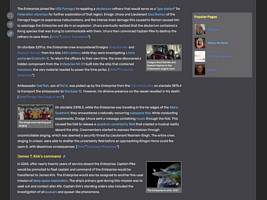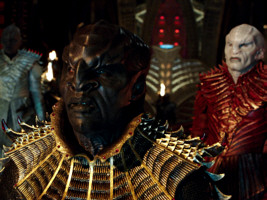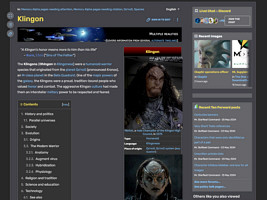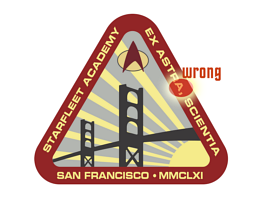Handling Canon Issues at EAS and at Memory Alpha
Star Trek has never been completely consistent, neither on the visual side nor with regard to its in-universe technology or history. At the beginning of the 21st century there was a broad consensus about how to deal with canon and continuity issues. This lasted until the relaunch of the Star Trek movie franchise in 2009 and the premiere of Star Trek Discovery in 2017, which came with an abundance of new problems. Canon criteria and interpretations have become controversial in fandom since then, and different fan sites and forums arrive at different conclusions. The following is a comparison of the standards at this site (EAS) and at Memory Alpha (MA).
Comparison of EAS and Memory Alpha Standards
There is a growing disagreement in the Star Trek fandom about
- which content is canon in the first place and which is sort of "less than canon".
- which contradicting canon facts are irreconcilable and which may co-exist.
- which visual discrepancies we have to disregard because it's a reboot and which qualify as an actual in-universe difference.
- which material, if any, should have precedence in case of contradictions: the classic or the reboot.
The official production probably has guidelines for canon issues. Yet, they are handled flexibly (in order not to limit "creative freedom"), they seem to differ between the series (Picard vs. DIS/SNW), they are subject to change (Klingons!) and they are not communicated except in blanket statements (like "everything we make is canon").
The fandom traditionally has much more elaborate views on such issues, with especially Memory Alpha being a yardstick even for official productions.
The policies of EAS and MA used to be largely aligned (in fact, the original canon policy of MA was copied from EAS). However, they diverge especially regarding the Star Trek productions after 2005. Strictly speaking, Memory Alpha uses a classification as "valid in-universe content" in more recent years, rather than "canon", which explains some of the differences.
Here are some examples:
 EAS: Animated series (other than Very Short Treks, which was explicitly exempted from canon) are acceptable material. They are tagged with "Trek Animated" because TAS was generally considered non-canon around the year 2000, and there is no final word yet.
EAS: Animated series (other than Very Short Treks, which was explicitly exempted from canon) are acceptable material. They are tagged with "Trek Animated" because TAS was generally considered non-canon around the year 2000, and there is no final word yet.
MA: There is no distinction between live-action and animated Trek, they are both considered "valid in-universe content". MA switched to this classification in order to avoid debates on canonicity (generally, and specifically regarding TAS).
EAS: Very Short Treks was explicitly declared "anything but canon" by Paramount and is completely ignored. Nothing from Very Short Treks happened in-universe in any form.
MA: Very Short Treks has the same weight in the database as "valid in-universe content", but with the additional tag "anything but canon".
 EAS: The term "Kelvin Timeline" is used to denote the timeline created by Nero in "Star Trek (2009)". Another informal term, "Abramsverse", serves to set apart the entirety of the three Abrams films from classic Trek.
EAS: The term "Kelvin Timeline" is used to denote the timeline created by Nero in "Star Trek (2009)". Another informal term, "Abramsverse", serves to set apart the entirety of the three Abrams films from classic Trek.
MA: "Kelvin Timeline" or other specific monikers are not used at all (except in annotations) because MA is written from a strictly in-universe viewpoint. The timeline created by Nero is just one of many alternate timelines in Star Trek. It is tagged in the same fashion as e.g. events from other time travel episodes.
 EAS: Visual discrepancies between classic Trek series are acknowledged. The visual discrepancies between DIS/SNW and classic Trek are addressed likewise. In other words, if two things look different that ought to be identical and any in-universe explanation would be fanwank, one has to be a visual reboot of the other and is called out as such. Visuals and other facts from DIS and SNW, where this is almost the rule, are therefore tagged with "Discoverse".
EAS: Visual discrepancies between classic Trek series are acknowledged. The visual discrepancies between DIS/SNW and classic Trek are addressed likewise. In other words, if two things look different that ought to be identical and any in-universe explanation would be fanwank, one has to be a visual reboot of the other and is called out as such. Visuals and other facts from DIS and SNW, where this is almost the rule, are therefore tagged with "Discoverse".
MA: Visual discrepancies between classic Trek series are acknowledged. Visual discrepancies between DIS/SNW and classic Trek are overlooked and thereby silently ascribed to the visual reboot principle without being marked as such. The in-universe database is designed to be consistent, rather than consequential.
EAS: The TOS Enterprise and the DIS/SNW re-imagination are very different designs with very different sizes on very different technology levels, and there is no way of reconciling them. The latter is a reboot (and more than "only" a visual one). It necessitates a separate entry in the starship database.
MA: The Enterprise from TOS and the one from DIS/SNW are identical in-universe. MA is not a starship database in the first place and disregards the visual and technical discrepancies and even the size issue (except perhaps in comments).
EAS: The creation of Discovery Klingons was an error. We might be allowed to ignore their existence (even retroactively in DIS), considering that their appearance remains totally isolated and they are 100% replaced with classic Klingons in SNW. At EAS, DIS-Klingons are not disregarded (because visuals matter) and called out as a (temporary) reboot.
MA: Some features of DIS-Klingons, such as the elongated skulls or the talons, are mentioned in the article on the species. These are rated as a range of anatomic varieties, not as specific differences of a (sub-)species. Regarding other characteristics, commonalities with classic Klingons are assumed. The isolated appearance of DIS-Klingons is not addressed. The issue of DIS-Klingons is explicitly discussed in a section of a real-life commentary.
EAS: A race named Illyrians appeared in ENT: "Damage". All of these Illyrians had alien make-up and there was not the slightest sign of them being genetically enhanced. In SNW, we see several Illyrians, most notably Una Chin-Riley. They are all completely indistinguishable from humans, if it were not for the genetic enhancement (which often goes unnoticed as well). These two species are very clearly not the same. Many of the countless T(a,e,y)rel(l)ians are not the same either.
MA: ENT-Illyrians and SNW-Illyrians are the same, apparently just because they have the same name.
Side note Well, MA does make a (necessary) distinction between the Alpha- and Delta-Ter(r)ellians despite the name coincidence. EAS, on the other hand, distinguishes between Trills and "Trills", although they do have one important feature besides the name in common. So both sites are not completely consequential.
EAS: In a (possible) future, the planet Vulcan will be named Ni'Var (because most fans agree on the early 25th century being the "current date").
MA: Ni'Var *is* the name of the planet formerly known as Vulcan (because the article is written from a 32nd century in-universe perspective).
EAS: In TOS: "Balance of Terror", the commander of Earth Outpost 4 is a white man with gray/blond hair of the last name Hansen. SNW: "A Quality of Mercy" shows the very same person as a bald man of Middle East descent with the first name Hansen, which is a (purposeful) continuity error.
MA: Hansen Al-Salah is the commander of Earth Outpost 4. His race and hair is subject to vary and/or is of no concern. For some unknown reason he is referred to by his first name in TOS.
EAS: Even though not strictly canon, ship names and registries from actual production sources and from licensed publications based on the latter (such as the Star Trek Encyclopedia or the Eaglemoss series) are "acceptable content" - unless overruled by canon evidence, of course.
MA: Content other than on-screen canon (with screen caps as proof or affirmations from designers like "This very ship hull or plaque was in the episode.") is ignored. There is no Angelou-class USS Maathai in the 32nd century because it is assumed the name was not on the model.
EAS: Nonsensical in-jokes on ship hulls or displays are always disregarded, as long as they are not clearly legible. There is no "USS Alka-selsior".
MA: The USS Alka-selsior exists and was present in TNG: "Unification I+II".
EAS: Factual errors are disregarded even when clearly visible, unless we could pass them as an in-universe mistake. The Starfleet Academy emblem never showed wrong Latin but was "Ex Astris Scientia" on all occasions without exception.
MA: The emblem with wrong Latin was posted at MA for many years because it was visible in the original version of TNG: "The First Duty". It was eliminated only after someone had embarrassingly based the design of a canon trophy for PIC on it.
Conclusion
I don't mean to criticize Memory Alpha for their standards and particular decisions. I am familiar with the policies of MA and I just want to point out that things are different at EAS and that there are usually reasons for it. In some regards EAS is more transparent, more objective or more consequential than MA. In other cases, it's the other way round.
EAS and MA agree about the following important points:
- All series and movies that the studio has explicitly or implicitly declared canon are treated as canon.
- On-screen canon always trumps secondary sources and licensed material.
- No made-up facts or far-fetched theories (aka fanwank) to explain canon issues.
- No arbitrary extensions or limitations of canon (aka headcanon).
See Also
What is Canon? - definitions, reasons, interpretations and the EAS canon policy
The Visual Continuity of Star Trek - examples of if and how visual continuity was maintained through the generations
The Continuities of Star Trek - from a single timeline to a multiverse(?), and how to deal with that
The Problems of Canonizing TAS - dealing with possible continuity and compatibility issues
Dealing with Continuity Issues of the Abramsverse - general thoughts and the policy at EAS
Discoverse Continuity Problems - where DIS and SNW are not in line with classic Star Trek
Dealing with Discovery Klingons - four options how future episode may handle the Klingon dilemma






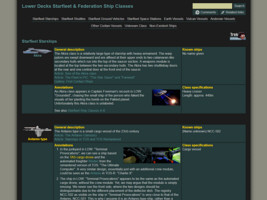
 Separate database for LOW ships at EAS
Separate database for LOW ships at EAS

